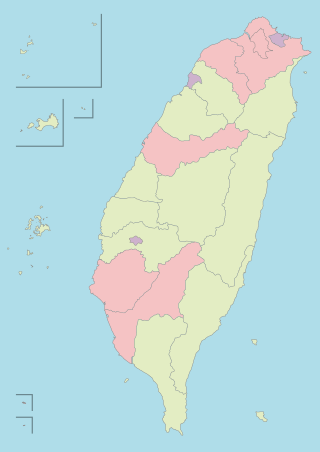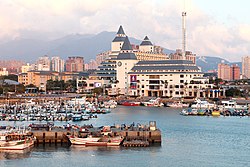
Taichung, officially Taichung City, is a special municipality located in central Taiwan. Taichung has approximately 2.85 million residents and is the second largest city of Taiwan, as well as the most populous city in Central Taiwan. It serves as the core of the Taichung–Changhua metropolitan area, the second largest metropolitan area in Taiwan.
Highways in Taiwan are classified into five types:
An art centre or arts center is distinct from an art gallery or art museum. An arts centre is a functional community centre with a specific remit to encourage arts practice and to provide facilities such as theatre space, gallery space, venues for musical performance, workshop areas, educational facilities, technical equipment, etc.

The Ministry of Culture is the ministry of the Republic of China (Taiwan) that promotes cultural and creative industries. The ministry also maintains the National Repository of Cultural Heritage.

Islam is a minor religion in Taiwan and it represents about 0.3% of the population. There are around 60,000 Muslims in Taiwan, in which about 90% belong to the Hui ethnic group. There are also more than 250,000 foreign Muslims working in Taiwan from Indonesia, Malaysia, Thailand and the Philippines, as well as other nationalities from more than 30 countries. As of 2018, there are eleven mosques in Taiwan, with the most notable being the Taipei Grand Mosque, the oldest and largest one.

The Taiwan Lantern Festival is an annual event hosted by the Tourism Bureau of the Ministry of Transportation and Communications in Taiwan to celebrate the Lantern Festival.

The following outline is provided as an overview of and topical guide to Taiwan:
Articles related to Taiwan include:
Districts are administrative subdivisions of the Republic of China (Taiwan)'s special municipalities of the second level and provincial cities of the third level formerly under its provinces. There are two types of district in the administrative scheme.

Special municipality, historically known as Yuan-controlled municipality, is a first-level administrative division unit in Taiwan. It is the highest level of the country's administrative structure and is equivalent to a province. After the suspension of the provincial governments of 2018, the special municipalities along with provincial cities and counties have all governed directly under the central government.
Events from the year 2011 in Taiwan, Republic of China. This year is numbered Minguo 100 according to the official Republic of China calendar.
Events from the year 2001 in Taiwan, Republic of China. This year is numbered Minguo 90 according to the official Republic of China calendar.
The architecture of Taiwan can be traced back to stilt housing of the aborigines in prehistoric times; to the building of fortresses and churches in the north and south used to colonize and convert the inhabitants during the Dutch and Spanish period; the Tungning period when Taiwan was a base of anti-Qing sentiment and Minnan-style architecture was introduced; in Qing dynasty period, a mix of Chinese and Western architecture appeared and artillery battery flourished during Qing's Self-Strengthening Movement; During the Japanese rule of Taiwan, the Minnan, Japanese and Western culture were main influencers in architectural designs and saw the introduction and use of reinforced concrete. Due to excessive Westernization as a colony, after the retrocession of Taiwan to the Republic of China in 1945 from Japan at the end of World War II, Chinese classical style became popular and entered into international mainstream as a postmodern design style. Today, Taiwanese architecture has undergone much diversification, every style of architecture can be seen.







